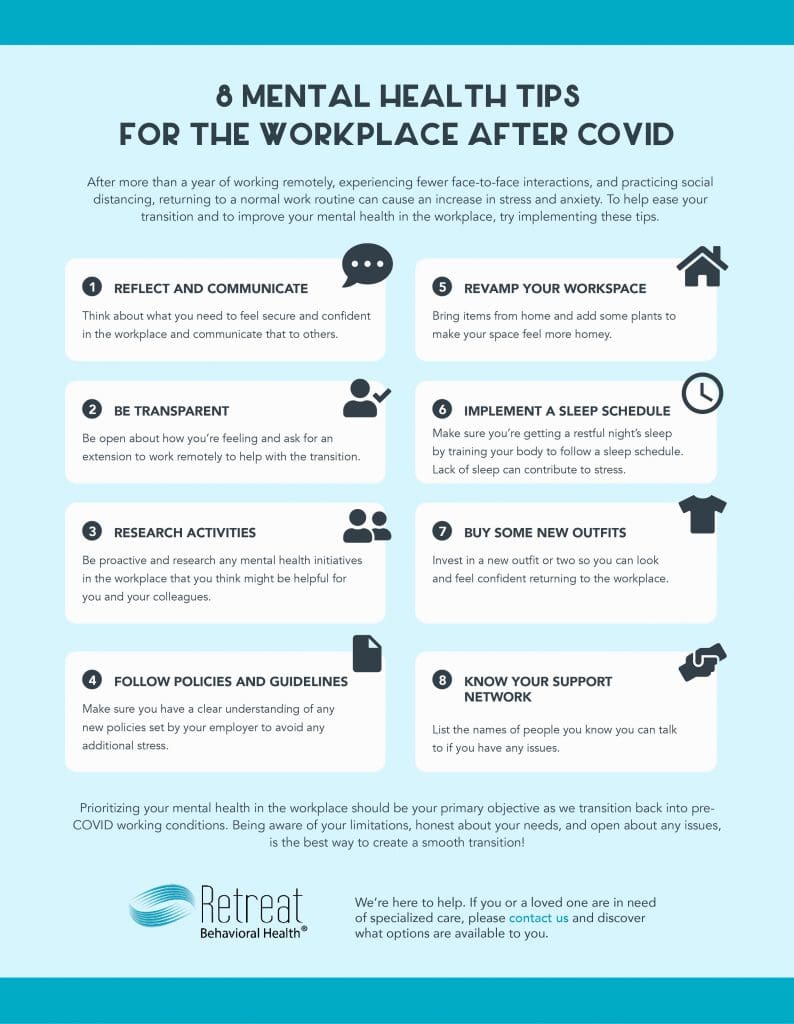Mental Health in the Workplace Following COVID
Managing your mental health in the workplace is always an extremely important aspect in maintaining a healthy work-life balance, but in the wake of COVID-19 it’s become an even more serious priority. For countless workers, returning to familiar routines and “going back to normal” may not be as easy as it sounds, especially for those already suffering from mental health disorders.
In order to reduce the possible negative impacts of resuming pre-COVID work life, we must understand how certain processes might have changed during the quarantine and lockdown. By taking the time to examine these differences, we can better take care of our mental health in the long run once in-office duties resume.
To Improve Mental Health In The Workplace, We Need To Understand What Changes Occurred During The Pandemic
Before we can implement helpful tips and changes to improve our mental health in the workplace, we need to understand how we, as a working society, changed during the pandemic. We all experienced less face-to-face interaction, and even when finding ourselves in situations that necessitated interaction, wearing masks and speaking through dividers inhibited our ability to connect. These changes can lead to a general increase in social aversion, or even create a defensive view of the people around us.
These newly acquired perspectives may cause increased stress, anxiety, and a fear of interacting face-to-face once pre-COVID operations resume.
There’s little we can do about how social distancing affects us. But, by making mental health a priority in the workplace as we transition back to “normal working conditions” in the months ahead, we can help subdue some of these anxieties before they manifest beyond our control.
Tips For Dealing With Mental Health Issues In The Workplace
Even if you’re less anxious about going back to work, dealing with mental health issues in the workplace is still important and we all should be monitoring our mental health and anxiety during this transition process.
One of the biggest tips is relearning personal and work life boundaries. After experiencing more than a year of flexibility, tips for creating boundaries again include:
- Reflect about what you want or need to feel secure and confident and articulate your wants and needs to others
- Be transparent about how you’re feeling and if you need an extension to work remotely
- Research and share some mental health initiatives in the workplace that you think might be helpful
- Understand the new policies and guidelines your employers have set
Some other tips you can follow to help your mental health going back to work after COVID:
- Gather the names of people you can talk to if issues arise
- Revamp your workspace by organizing, bringing items from home, or adding a plant
- Prepare a sleep schedule leading up to your first day back
- Invest in a new wardrobe (or buy an outfit or two)
Retreat Behavioral Health
Whether you’re excited, indifferent, or a little nervous about going back to work, being aware of your mental health is the best way to create a smooth and healthy transition. Focus on the positive things, such as reuniting with your friends at work and becoming more active.
Questions about mental health? Need guidance about stress or anxiety as you return to the office full-time? Contact us by scheduling an appointment today.





